Alchemilla mollis
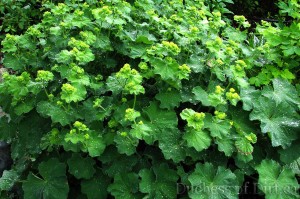 Alchemilla mollis Family: Rosaceae
Alchemilla mollis Family: Rosaceae
(al-kem-ILL-ah MAWL-iss)
syn. Alchemilla vulgaris
Common name: lady’s mantle
Zone: 3 – 8
Height: 18 – 24 in (45 – 60 cm)
Spread:18 – 24 in (45 – 60 cm)
Aspect: full sun; partial shade
Soil: average
Water: moderate
Description: An herbaceous perennial with good ground-covering foliage that forms a neat mound. Soft, pale grey-green rounded leaves are lobed and have crinkled edges. Airy sprays of tiny greenish-yellow flowers from spring to mid-summer.
Special Notes: Native to Greece, Turkey and Caucasus. The 2 – 4 inch (5 – 10 cm) leaves hold small droplets of water and dew. Good cut flower; dries well for floral arranging. Prolific self-seeder. Cut entire plant back to ground when flowers are spent and before they set seed. Relatively pest and disease free. May get powdery mildew in hot humid climate. Drought tolerant. Propagation by seed; division in spring or autumn.
RHS Award of Garden Merit 1993
Posted on December 17, 2012; updated on August 6, 2024
Anemone x hybrida ‘September Charm’
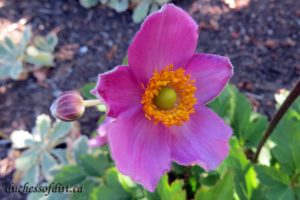 Anemone x hybrida ‘September Charm’
Anemone x hybrida ‘September Charm’
(ah-NEM-oh-nee ex HY-brid-ah)
Syn. Anemone hupehensis var. japonica ‘September Morn’
Family: Ranunculaceae
Common name: Japanese anemone; windflower
Zone: 4 – 8
Height: 24-36 in (60-90 cm)
Spread: 24 in (60 cm)
Aspect: full sun; part shade
Soil: average; well-draining
Water: moderate
Description: An erect, fibrous-rooted, spreading herbaceous perennial. Height is usually two to three feet (60 – 90 cm), but has been known to reach four feet (120 cm). Single, branching, wiry stem rises above a dark green mound of trifoliate leaves. Each branch extending from the central stem supports a 2 – 3 in (5 – 7.5 cm) diameter flower of typically five purely delightful silver-pink petals, blushed with dark rose shading, surrounding a central grouping of bright yellow stamens.
Special Notes: A garden hybrid from suspected parentage of Anemone hupehensis var. japonica and Anemone vitifolia. With a bloom period stretching from mid-August through to October, this is a wonderful flowering perennial for late season interest in the garden.
Since the flowers are sterile, the plant increases from its fibrous roots which may be a problem for some gardeners. Spread is not so quick, however, that the plant cannot be kept within boundaries using a sharp spade to curb the expansion and pulling up the wandering offspring.
Pot up the offshoots to share with friends and fellow gardeners…or dry them out in a hot sun to kill them before adding them to your compost. But do make sure the unwanted plants are clearly expired before you throw them into your compost bin!
In our Zone 7a garden: In spite of this perennial being a spreader, we do enjoy its presence in our garden. The flowers are a welcome addition and even though the flowers are purported to be sterile, I have seen various winged insects on the bright yellow stamens. There must be something beneficial buried in there for them which is an attractant.
Royal Horticultural Society Award of Garden Merit (AGM) 1993
Posted on October 4, 2017; updated on August 6, 2024
Ajuga reptans BLACK SCALLOP
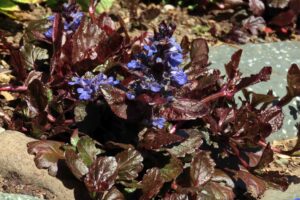 Ajuga reptans BLACK SCALLOP
Ajuga reptans BLACK SCALLOP
(ah-JEW-gah REP-tanz)
syn. Ajuga reptans ‘Binblasca’ PBR
Family: Lamiaceae
Common name: bugleweed; carpet bugleweed
Zone: 4 – 9
Height: 3 – 6 in (7.5 – 15 cm)
Spread: 6 – 24 in (15 – 60 cm)
Aspect: sun; partial shade
Soil: fertile; well-draining
Water: moderate
Description: An evergreen groundcover with glossy, dark maroon-purple to almost black, scalloped-edged leaves and a dense habit. Short, upright, spikes of dark violet, fragrant flowers four to six inches tall (10 – 15 cm) appear in mid- to late spring.
Special Notes: The genus Ajuga is native to Europe. BLACK SCALLOP is a mutation of Ajuga reptans ‘Braunherz’, discovered in an in-vitro nursery laboratory in 1998 and subsequently isolated to be developed and introduced as a new cultivar, Ajuga reptans ‘Binblasco’ PBR. U.S. Plant Patent was issued in June 2005. (PBR – Plant Breeder Registration)
BLACK SCALLOP tends to have a more compact habit than some of the other Ajuga cultivars. Plant where it will get more sun for deep, rich foliage colour but plants will require watering more often. In hotter climates, give it a little more shade from the sun.
Propagate by cutting the stolon, or plantlet, growing out from the mother plant to start a new plant. BLACK SCALLOP does not come true from seed.
Crown rot can be a problem if ajugas are allowed to grow too densely. Divide clumps every few years to thin the planting out. Aphids, slugs, snails and whiteflies can also be occasionally problematic. And while it is not unheard of for cucumber mosaic virus and tobacco mosaic virus to attack ajugas, there have been no reports of these viruses found on BLACK SCALLOP. However, remove the plants if you see these viruses and bag them for the garbage.
In our Zone 7a garden: We now have a few patches of BLACK SCALLOP in our landscape and we love them! Absolutely the best-behaved ajuga to plant in your garden for its dark leaves and dark violet flowers.
Posted on February 3, 2021; updated on August 6, 2024
Allium flavum
 Allium flavum Family: Liliaceae
Allium flavum Family: Liliaceae
(AL-ee-um FLAH-vum)
Common name: ornamental onion; small yellow onion
Zone: 5 – 8
Height: 10 – 12 in (25 – 30cm)
Spread: 4 in (10 cm)
Aspect: full sun; partial shade
Soil: fertile; well-draining
Water: moderate
Description: A bulbous herbaceous perennial which produces an umbel of lemon-yellow, bell-shaped flowers in late spring through early summer. Narrow, strap-like, blue-green leaves will wither as the flowers mature.
Special Notes: An heirloom dating back to the late 1750s. Native to region surrounding the Mediterranean, Black and Caspian Seas; France, Morocco to Iran, Kazakhstan. A relative to culinary onions and garlic. Good for containers and rockeries. Plant bulbs 3 – 4 times their own depth in autumn. Naturalizes to create a pleasing display. Attracts bees. Can fall prey to the same diseases which afflict onions and garlic. Deer resistant.
Awards: Royal Horticultural Society’s Award of Garden Merit (AGM) in 1993.
Posted on February 17, 2021; updated on August 6, 2024
Ageratina altissima ‘Chocolate’
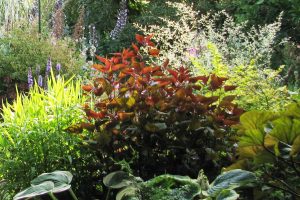 Ageratina altissima ‘Chocolate’
Ageratina altissima ‘Chocolate’
(ah-jur-ah-TY-nah al-tis-SIH-mah)
syn. Eupatorium rugosum ‘Chocolate’
Family: Asteraceae
Common name: white snakeroot; purple bugbane
Zone: 4 – 9
Height: 4 – 5 ft (1.2 – 1.5 m)
Spread: 2 – 3 ft (60 – 90 cm)
Aspect: full sun; partial shade
Soil: fertile; moist; well-draining
Water: regular
 Description: An herbaceous perennial with an upright, clump-forming growth habit. Delightfully dark maroon-brown, oblong, toothed leaves on burgundy stems. Small, fluffy white flowers appear in late summer through autumn.
Description: An herbaceous perennial with an upright, clump-forming growth habit. Delightfully dark maroon-brown, oblong, toothed leaves on burgundy stems. Small, fluffy white flowers appear in late summer through autumn.
Special Notes: Native to North America. Quite tolerant of a range of soil conditions. Foliage is darker with more sun but plant will need more frequent water. Good cut flower. Attracts bees and butterflies. Deer and rabbit resistant. Relatively pest and disease free. Propagate by division in spring or autumn; softwood cuttings in summer. Will not come true from seed
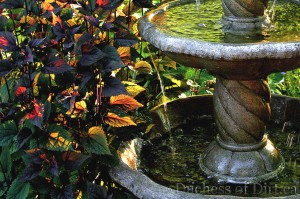 Caution: All parts of the plant are toxic to humans and animals. Cows, goats, sheep, etc. may graze on this plant. The toxin is passed to humans through drinking the milk from these animals.
Caution: All parts of the plant are toxic to humans and animals. Cows, goats, sheep, etc. may graze on this plant. The toxin is passed to humans through drinking the milk from these animals.
In our Zone 7a garden: We adore this plant for its rich foliage colour. A medium tall backdrop plant for showing off shorter plants with variegated, gold. or light green foliage. ‘Chocolate’ blooms late in the season in our garden, mid-August or early September. As the blooms are quite insignificant, we do not miss them, as the fall colours in the foliage are much preferred.
Great Plant Pick 2004
Posted on May 1, 2013; updated on August 6, 2024
